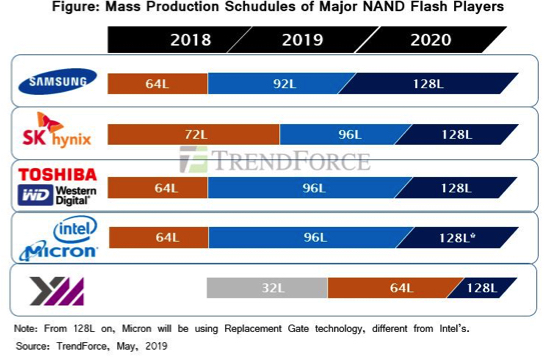Yangtze Memory Technologies to Mass Produce 64-Layer 3D NAND Products by Year End
To impact NAND flash prices upon expansion in 2020
This is a Press Release edited by StorageNewsletter.com on May 16, 2019 at 2:12 pmDue to frictions from the US-China trade dispute, China’s two DRAM giants are showing clear signs of slowing.
According to research by DRAMeXchange, a division of TrendForce, Inc., Yangtze Memory Technologies (YMTC), which forms the main bulwark of NAND flash development in China, will be mass producing 64-layer Xtacking 3D NAND products this year end as scheduled. YMTC’s capacity expansion in 2020 is projected to impact supply and prices in the global NAND flash market.
YMTC has already sent examples to some of its customers and controller suppliers in 1Q, focusing on domestic sales in the early stages.
They have also wrapped up construction of their Wuhan plant, and have allocated limited capacity to 32-layer products, waiting until the mass production of 64-layer production to switch to a more proactive stance and expand capacity.
Plans are to enlarge production capacity in 2020, bring wafer production up to at least 60,000/m. Although this can’t be considered large compared to other competitors, who boast capacities of over 200,000/m, it is still expected to have a certain impact on NAND flash market prices and prolong the falling trend.
China is clear in its resolve to deploy new production capacity in hopes of achieving self-sufficiency. Other international suppliers have opened up new plants in anticipation of the competition post-2020, including Samsung’s phase 2 investment into its Xi’ An plant, Toshiba’s new Iwate fab, Micron’s third plant in Singapore, SK Hynix’s utilization of the remaining space in the M15 plant and the following M16 plant, etc.
One may expect the price competition to get ugly after suppliers’ capacities have risen.
YMTC to Tackle 128-Layer Products Straight on Next Year
in Attempt to Narrow 1-2 Year Technology Gap With First-Tier Plants
Judging from the developments of the top six suppliers, mainstream shipments consist of 64/72-layer products, while 92/96-layer products have already entered mass production. UFS, SSD products are being provided to customers for qualification, yet the expansion of new production processes have been affected by this year’s market. Suppliers have been lowering Capex since the end of last year and spreading out expansion schedules. Some suppliers have even decided to cut back production, slowing proportion growth of new production processes.
In contrast to other suppliers who’ve taken to developing 9x-layer products as their first move, YMTC chose to tackle 128-layer products straight on to narrow the gap between them and other suppliers; other major players will be mass producing 128-layer products further down the timeline in 2020. Despite the considerable technological gap between YMTC and other suppliers, YMTC’s impact on the future market is inevitable and unstoppable.















 Subscribe to our free daily newsletter
Subscribe to our free daily newsletter

